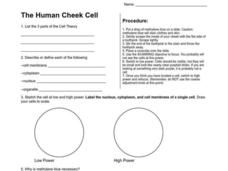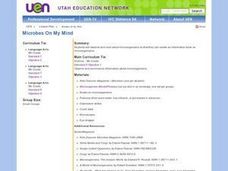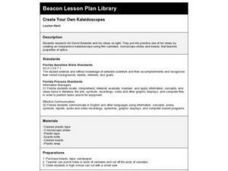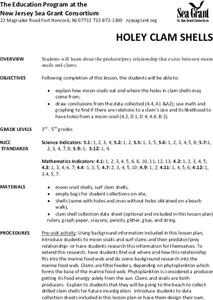Curated OER
And the Bacteria Ran Away with the Petri Dish
Sixth graders complete a think, pair, share activity on an antibiotic overhead. In groups, they participate in an exercise in which they can see how germs behave and how they are treated. To end the lesson, they discuss how a...
Curated OER
Diseases
Sixth graders create a type of notebook or journal using colored copy paper on which to take notes. They complete research on a certain disease and report on it and then design their own disease causing bacteria or virus. Finally, 6th...
Curated OER
The Human Cheek Cell
In this human cells worksheet, 7th graders complete a science experiment using human cheek cells. Students sketch the cells at high and lower power and label the cell nucleus, cytoplasm, and cell membrane.
Curated OER
Algae--Where does it Live?
Students discover algae. In this science lesson plan, students examine what green algae is and where it grows. Students test the growth of algae in four different types of water: lake water, well water, distilled water and tap water
Curated OER
Cells Are Us
Young scholars explore cells. For this science lesson plan, students investigate how the cell is the basic unit of life, that cells divide slowly to become mass of cells, and that there is a gradual loss of cells throughout life.
Curated OER
Guess What?!
Students explore how scientists work. In this scientific method activity, students use their senses to identify objects they cannot see. Students are asked to think like scientists and make observations, comparisons, and interferences,...
Curated OER
Bridges for All: Better Way
Middle schoolers explore organizations founded for the common good. In this character education instructional activity, students read about organizations that developed for the common good during the Civil War and Reconstruction. In...
Curated OER
Dinosaurs 1: Where Are the Dinosaurs?
Students explore dinosaurs and their extinction. In this dinosaur lesson, students view dinosaur websites and videos to gain an understanding of the world long ago. Discussion questions follow. Students create a paper mache dinosaur egg.
Curated OER
Let's Learn About Lettuce
Students learn more about lettuce. In this agriculture activity, students listen to their instructor lecture about the history of lettuce. Students then participate in an activity that requires them to compare and contrast iceberg...
Curated OER
Amoeba This!!! Amoeba That!!!
Students investigate protozoa. In this protozoa lesson, students identify and classify different types of protozoa using different ecological samples and protozoa charts.
Curated OER
Pond Ecosystem Field Trip
Students investigate the environment by participating in a class trip. In this pond ecosystem lesson, students define a list of vocabulary terms associated with ponds such as invertebrate and metamorphosis. Students attend a field trip...
Curated OER
Selling Cells: a Study of Organelles and Cell Structure
Students study cellular structures and functions. In this cell function lesson students participate in a class discussion then make a drawing of the cell they are discussing.
Curated OER
Critters in the Classroom
Students investigate with sea urchins. In this ocean habitat lesson, students observe sea urchins and other ocean grazers. Students work with lab equipment to examine the anatomy of these creatures.
Curated OER
Technology and the Human Eye
Fifth graders compare technology and the human eye. In this science lesson, 5th graders label the parts of the human eye and trace the path of light as it travels through the eye.
Curated OER
Butterfly Round-Up
Students classify the characteristics of butterflies and moths moths. In this life cycle lesson plan, students identify butterflies and moths common in the state of Iowa as well as their characteristics. Students then learn the proper...
Curated OER
Life in a Drop of Water
Young scholars observe the wealth of living organisms in a drop of water from our freshwater ecosystems. They classify the types of organisms observed as single-celled or multi-cellular and use a key or chart to identify and name the...
Curated OER
A Better Way
Students increase awareness of organizations that grew out of necessity and increased social consciousness during the Civil War and Reconstruction. They trace the origins of three organizations founded for the common good. They link...
Curated OER
Microbes on My Mind
Students observe and read about microorganisms so that they can create an information book on microorganisms.
Curated OER
Sea Connections: Marine Ecosystems
Students identify producers and consumers from marine ecosystems and describe the balance among them in the environments. After constructing a food chain from a marine ecosystem, they examine human activities that can upset the balance...
Curated OER
Lab Report Template
Students write a paragraph (complete sentences) which explains what they did in the lab.
Curated OER
Create Your Own Kaleidoscopes
Seventh graders create a kaleidoscopes after researching Sir David Brewster and his ideas on light. They recognize the properties of optics from making and using the kaleidoscopes.
Curated OER
Does the increased use of fertilizers effect biodiversity?
Students conduct a hands-on lab activity in which they analyze a sample of water from a local stream or pond. They introduce a fertilizer solution into the sample and analyze and describe their findings.
Curated OER
Does the Introduction of Pesticides and Fertilizers Alter an Aquatic Ecosystem?
Learners conduct an experiment using a small sample from a local water source. They introduce fertilizers and pesticides, separately, and carefully examine the results in their simulated aquatic ecosystem.
Curated OER
Holey Clamshells
Students analyze data to make hypotheses and conclusions regarding the predator/prey relationship between moon snail and surf clams.
Other popular searches
- Parts of a Microscope
- Compound Microscopes
- Label Compound Microscope
- Dissection Microscopes
- Microscope Cheek Cells
- Digital Microscope
- Microscope Lab
- Biology Lab Microscopes
- Scanning Electron Microscopes
- Cheek Cells and Microscopes
- Lesson Plan on Microscopes
- Lenses and Microscopes

























